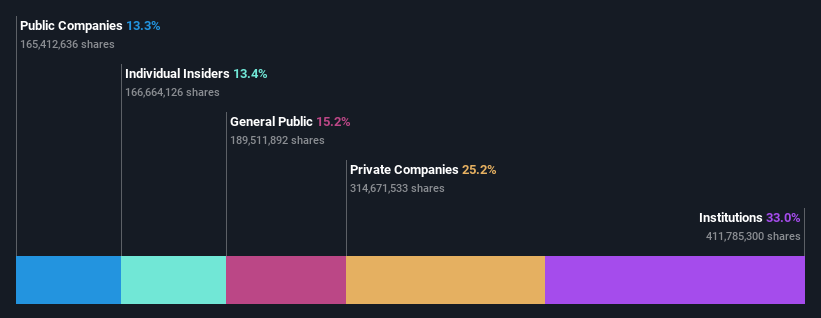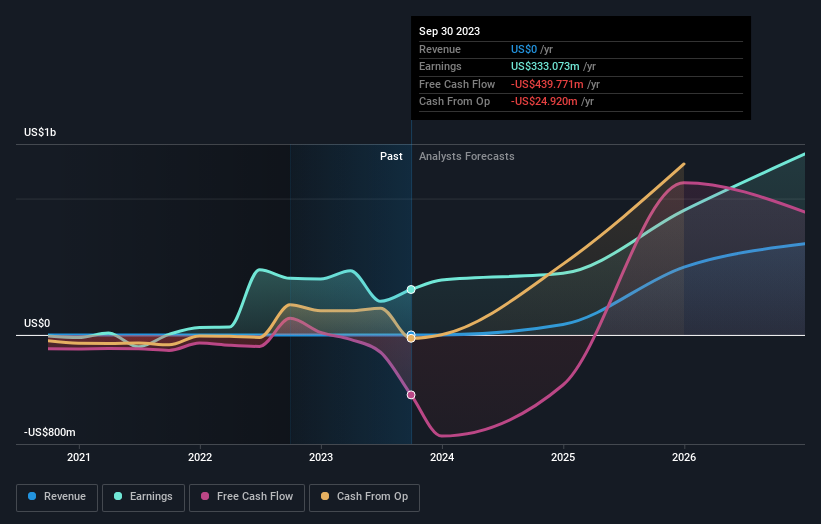Ivanhoe Mines Ltd. (TSE:IVN) is largely controlled by institutional shareholders who own 33% of the company
Key Insights
Given the large stake in the stock by institutions, Ivanhoe Mines' stock price might be vulnerable to their trading decisions
52% of the business is held by the top 3 shareholders
If you want to know who really controls Ivanhoe Mines Ltd. (TSE:IVN), then you'll have to look at the makeup of its share registry. And the group that holds the biggest piece of the pie are institutions with 33% ownership. In other words, the group stands to gain the most (or lose the most) from their investment into the company.
Since institutional have access to huge amounts of capital, their market moves tend to receive a lot of scrutiny by retail or individual investors. As a result, a sizeable amount of institutional money invested in a firm is generally viewed as a positive attribute.
Let's delve deeper into each type of owner of Ivanhoe Mines, beginning with the chart below.
See our latest analysis for Ivanhoe Mines
What Does The Institutional Ownership Tell Us About Ivanhoe Mines?
Many institutions measure their performance against an index that approximates the local market. So they usually pay more attention to companies that are included in major indices.
We can see that Ivanhoe Mines does have institutional investors; and they hold a good portion of the company's stock. This can indicate that the company has a certain degree of credibility in the investment community. However, it is best to be wary of relying on the supposed validation that comes with institutional investors. They too, get it wrong sometimes. It is not uncommon to see a big share price drop if two large institutional investors try to sell out of a stock at the same time. So it is worth checking the past earnings trajectory of Ivanhoe Mines, (below). Of course, keep in mind that there are other factors to consider, too.
Ivanhoe Mines is not owned by hedge funds. CITIC Group Corporation is currently the largest shareholder, with 25% of shares outstanding. With 13% and 13% of the shares outstanding respectively, Zijin Mining Group Company Limited and Robert Martin Friedland are the second and third largest shareholders. Robert Martin Friedland, who is the third-largest shareholder, also happens to hold the title of Co-Chairman of the Board.
A more detailed study of the shareholder registry showed us that 3 of the top shareholders have a considerable amount of ownership in the company, via their 52% stake.
Researching institutional ownership is a good way to gauge and filter a stock's expected performance. The same can be achieved by studying analyst sentiments. There are a reasonable number of analysts covering the stock, so it might be useful to find out their aggregate view on the future.
Insider Ownership Of Ivanhoe Mines
While the precise definition of an insider can be subjective, almost everyone considers board members to be insiders. Management ultimately answers to the board. However, it is not uncommon for managers to be executive board members, especially if they are a founder or the CEO.
I generally consider insider ownership to be a good thing. However, on some occasions it makes it more difficult for other shareholders to hold the board accountable for decisions.
Our most recent data indicates that insiders own a reasonable proportion of Ivanhoe Mines Ltd.. It has a market capitalization of just CA$18b, and insiders have CA$2.3b worth of shares in their own names. That's quite significant. Most would be pleased to see the board is investing alongside them. You may wish to access this free chart showing recent trading by insiders.
General Public Ownership
With a 15% ownership, the general public, mostly comprising of individual investors, have some degree of sway over Ivanhoe Mines. This size of ownership, while considerable, may not be enough to change company policy if the decision is not in sync with other large shareholders.
Private Company Ownership
It seems that Private Companies own 25%, of the Ivanhoe Mines stock. It might be worth looking deeper into this. If related parties, such as insiders, have an interest in one of these private companies, that should be disclosed in the annual report. Private companies may also have a strategic interest in the company.
Public Company Ownership
It appears to us that public companies own 13% of Ivanhoe Mines. It's hard to say for sure but this suggests they have entwined business interests. This might be a strategic stake, so it's worth watching this space for changes in ownership.
Next Steps:
It's always worth thinking about the different groups who own shares in a company. But to understand Ivanhoe Mines better, we need to consider many other factors. To that end, you should learn about the 3 warning signs we've spotted with Ivanhoe Mines (including 2 which don't sit too well with us) .
If you would prefer discover what analysts are predicting in terms of future growth, do not miss this free report on analyst forecasts.
NB: Figures in this article are calculated using data from the last twelve months, which refer to the 12-month period ending on the last date of the month the financial statement is dated. This may not be consistent with full year annual report figures.
Have feedback on this article? Concerned about the content? Get in touch with us directly. Alternatively, email editorial-team (at) simplywallst.com.
This article by Simply Wall St is general in nature. We provide commentary based on historical data and analyst forecasts only using an unbiased methodology and our articles are not intended to be financial advice. It does not constitute a recommendation to buy or sell any stock, and does not take account of your objectives, or your financial situation. We aim to bring you long-term focused analysis driven by fundamental data. Note that our analysis may not factor in the latest price-sensitive company announcements or qualitative material. Simply Wall St has no position in any stocks mentioned.

 Yahoo Finance
Yahoo Finance 

